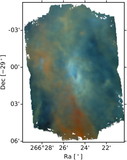A Detection of Sgr A* in the Far Infrared
Abstract
We report the first detection of the Galactic Center massive black hole, Sgr A*, at 100 μm and 160 μm. Our measurements were obtained with PACS on board the Herschel satellite. While the warm dust in the Galactic Center is too bright to allow for a direct detection of Sgr A*, we measure a significant and simultaneous variation of its flux of {{Δ }}{F}ν \hat{=160μ {{m}}}=(0.27+/- 0.06) {{Jy}} and {{Δ }}{F}ν \hat{=100μ {{m}}}=(0.16+/- 0.10) {{Jy}} during one observation. The significance level of the variability in the 160 μm band is 4.5σ, and the corresponding variability in the 100 μm band is significant at 1.6σ. We find no example of an equally significant false positive detection. Conservatively assuming a variability of 25% in the FIR, we can provide upper limits to the flux. Comparing the latter with theoretical models, we find that 1D radiatively inefficient accretion flow models have difficulties explaining the observed faintness. However, the upper limits are consistent with modern observations by ALMA and the Very Large Array. Our upper limits provide further evidence for a spectral peak at ∼1012 Hz and constrain the number density of γ ∼ 100 electrons in the accretion disk and/or outflow.
- Publication:
-
The Astrophysical Journal
- Pub Date:
- August 2018
- DOI:
- 10.3847/1538-4357/aacd4b
- arXiv:
- arXiv:1806.07395
- Bibcode:
- 2018ApJ...862..129V
- Keywords:
-
- accretion;
- accretion disks;
- black hole physics;
- Galaxy: center;
- Astrophysics - Astrophysics of Galaxies
- E-Print:
- accepted for publication in APJ
